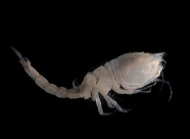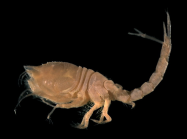WoRMS taxon details
Diastylis bradyi Norman, 1879
110472 (urn:lsid:marinespecies.org:taxname:110472)
accepted
Species
marine, brackish, fresh, terrestrial
Norman, A. (1879). VI.—Crustacea Cumacea of the ‘Lightning,' ‘Porcupine,' and ‘Valorous' Expeditions. <em>Annals and Magazine of Natural History.</em> 3(13): 54-73., available online at https://doi.org/10.1080/00222937908682476
page(s): 59 [details]
page(s): 59 [details]
Distribution The distribution of O. bradyi in the Dutch part of the North Sea is very patchy. Highest densities are found in the eastern...
Distribution The distribution of O. bradyi in the Dutch part of the North Sea is very patchy. Highest densities are found in the eastern part, near the German Bight. [details]
Watling, L.; Gerken, S. (2024). World Cumacea Database. Diastylis bradyi Norman, 1879. Accessed through: World Register of Marine Species at: https://marinespecies.org/aphia.php?p=taxdetails&id=110472 on 2024-04-16
Date
action
by
![]() The webpage text is licensed under a Creative Commons Attribution 4.0 License
The webpage text is licensed under a Creative Commons Attribution 4.0 License
original description
Norman, A. (1879). VI.—Crustacea Cumacea of the ‘Lightning,' ‘Porcupine,' and ‘Valorous' Expeditions. <em>Annals and Magazine of Natural History.</em> 3(13): 54-73., available online at https://doi.org/10.1080/00222937908682476
page(s): 59 [details]
context source (Schelde) Janssen, C.R.; Ghekiere, A.; Verslycke, T.; Vincx, M.; Fockedey, N.; Rappé, K.; De Brabander, H.; Noppe, H.; Roose, P.; Monteyne, E.; Vethaak, D.; Mees, J.; Deneudt, K. (2007). Endocrine disruption in the Scheldt estuary distribution, exposure and effects (ENDIS-RISKS). <em>Final report. Belgian Science Policy: Brussels.</em> 106 pp. (look up in IMIS) [details]
context source (BeRMS 2020) Bio-environmental research group; Institute of Agricultural and Fisheries research (ILVO), Belgium; (2015): Macrobenthos monitoring in function of the Water Framework Directive in the period 2007-2009. [details]
basis of record Watling, L. (2001). Cumacea, <B><I>in</I></B>: Costello, M.J. <i>et al.</i> (Ed.) (2001). <i>European register of marine species: a check-list of the marine species in Europe and a bibliography of guides to their identification. Collection Patrimoines Naturels,</i> 50: pp. 308-310 (look up in IMIS) [details]
additional source Muller, Y. (2004). Faune et flore du littoral du Nord, du Pas-de-Calais et de la Belgique: inventaire. [Coastal fauna and flora of the Nord, Pas-de-Calais and Belgium: inventory]. <em>Commission Régionale de Biologie Région Nord Pas-de-Calais: France.</em> 307 pp., available online at http://www.vliz.be/imisdocs/publications/145561.pdf [details]
additional source Zimmer, C. (1933). Cumacea. <i>The fauna of the North Sea and Baltic</i>, 23(10.g4). Akademische Verlagsgesellschaft: Leipzig, Germany. 70-120 pp. (look up in IMIS) [details]
page(s): 59 [details]
context source (Schelde) Janssen, C.R.; Ghekiere, A.; Verslycke, T.; Vincx, M.; Fockedey, N.; Rappé, K.; De Brabander, H.; Noppe, H.; Roose, P.; Monteyne, E.; Vethaak, D.; Mees, J.; Deneudt, K. (2007). Endocrine disruption in the Scheldt estuary distribution, exposure and effects (ENDIS-RISKS). <em>Final report. Belgian Science Policy: Brussels.</em> 106 pp. (look up in IMIS) [details]
context source (BeRMS 2020) Bio-environmental research group; Institute of Agricultural and Fisheries research (ILVO), Belgium; (2015): Macrobenthos monitoring in function of the Water Framework Directive in the period 2007-2009. [details]
basis of record Watling, L. (2001). Cumacea, <B><I>in</I></B>: Costello, M.J. <i>et al.</i> (Ed.) (2001). <i>European register of marine species: a check-list of the marine species in Europe and a bibliography of guides to their identification. Collection Patrimoines Naturels,</i> 50: pp. 308-310 (look up in IMIS) [details]
additional source Muller, Y. (2004). Faune et flore du littoral du Nord, du Pas-de-Calais et de la Belgique: inventaire. [Coastal fauna and flora of the Nord, Pas-de-Calais and Belgium: inventory]. <em>Commission Régionale de Biologie Région Nord Pas-de-Calais: France.</em> 307 pp., available online at http://www.vliz.be/imisdocs/publications/145561.pdf [details]
additional source Zimmer, C. (1933). Cumacea. <i>The fauna of the North Sea and Baltic</i>, 23(10.g4). Akademische Verlagsgesellschaft: Leipzig, Germany. 70-120 pp. (look up in IMIS) [details]
 Present
Present  Present in aphia/obis/gbif/idigbio
Present in aphia/obis/gbif/idigbio  Inaccurate
Inaccurate  Introduced: alien
Introduced: alien  Containing type locality
Containing type locality
From other sources
Biology The majority of cumacean species in temperate shallow waters probably lives for a year or less and breeds twice each year. They feed on micro-organisms and organic matter from the bottom deposit (Jones, 1976). [details]Distribution The distribution of O. bradyi in the Dutch part of the North Sea is very patchy. Highest densities are found in the eastern part, near the German Bight. [details]
Habitat O. bradyi lives in all kinds of sediment, from coarse to very fine sand, often associated with mud. [details]
Morphology O. bradyi can grow up to 12 mm long. lt has a carapace with an acute pseudorostrum (Jones, 1976; Hayward & Ryland, 1990). [details]


